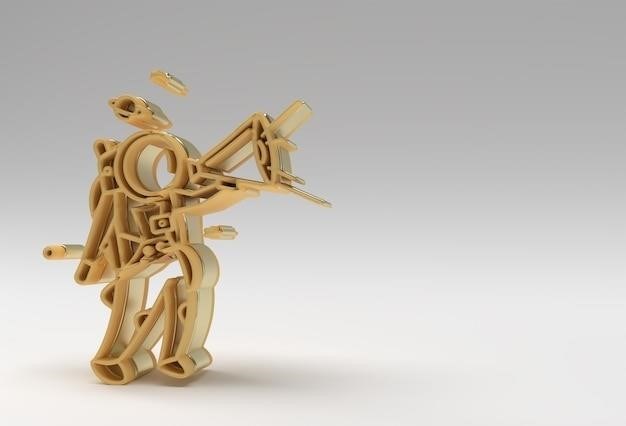The Evidence for Evolution
Evolution is a fundamental concept in biology, explaining the diversity of life on Earth․ There is a wealth of evidence supporting this theory, from the fossil record to molecular biology․ This evidence demonstrates that life has changed over time, with new species arising and others becoming extinct․ These changes are driven by natural selection, where organisms with advantageous traits are more likely to survive and reproduce․ The theory of evolution is a cornerstone of modern biology, providing a framework for understanding the history and diversity of life․
The Fossil Record
The fossil record provides a tangible history of life on Earth․ Fossils, the preserved remains of ancient organisms, reveal a gradual change in life forms over millions of years․ This record shows that species have evolved, with new species appearing and others disappearing․ The presence of transitional fossils, which exhibit characteristics of both ancestral and descendant species, strengthens the evidence for evolution․ For example, fossils of Tiktaalik, a fish with limb-like fins, bridge the gap between aquatic and terrestrial vertebrates, providing a glimpse into the evolution of land animals from fish․ The fossil record, therefore, offers compelling evidence for the evolutionary process․
Comparative Anatomy
Comparative anatomy reveals striking similarities and differences between the anatomical structures of diverse organisms․ Homologous structures, such as the forelimbs of humans, bats, and whales, share a common underlying structure despite serving different functions․ This suggests a common ancestry from which these structures have diverged through evolutionary adaptation․ In contrast, analogous structures, like the wings of birds and insects, serve similar functions but have different underlying structures, indicating convergent evolution․ Vestigial structures, such as the human appendix or the pelvic bones of whales, are remnants of structures that were functional in ancestral organisms but have lost their original function․ These anatomical comparisons provide strong evidence for common descent and the evolutionary process․
Embryology
The study of embryonic development provides compelling evidence for evolution․ Early embryos of diverse vertebrate species exhibit remarkable similarities, suggesting a shared evolutionary history․ For example, human embryos possess gill slits and a tail, features that are characteristic of fish and other aquatic vertebrates․ These transient structures reflect the evolutionary heritage of our aquatic ancestors․ As embryos develop, they diverge along distinct evolutionary pathways, leading to the diverse forms of adult organisms․ These developmental similarities, alongside the presence of vestigial structures in adults, strongly support the theory of common descent and evolution․
Molecular Biology
Molecular biology provides some of the most powerful evidence for evolution․ By comparing the DNA and protein sequences of different organisms, scientists can identify shared ancestry and reconstruct evolutionary relationships․ The genetic code, which translates DNA into proteins, is remarkably consistent across all forms of life, suggesting a common origin․ Furthermore, the presence of homologous genes, those with similar sequences and functions, indicates that organisms share a common ancestor․ The accumulation of mutations over time leads to gradual changes in DNA sequences, providing a molecular clock that can be used to estimate the time of divergence between species․ The insights from molecular biology provide compelling evidence for the evolutionary relationships between organisms․
The Fossil Record⁚ A Timeline of Life
Fossils provide a tangible record of life’s history, showcasing the evolution of organisms over millions of years․ They reveal the sequence of life’s appearance and extinction, offering evidence of change and diversification․
Transitional Fossils
Transitional fossils are crucial pieces of evidence for evolution․ They represent intermediate forms between ancestral and modern species, showcasing the gradual changes that occurred over time․ These fossils bridge the gap between different groups, revealing the evolutionary path leading to modern organisms․ For example, Tiktaalik roseae, a fossil discovered in 2006, exhibits characteristics of both fish and early tetrapods, demonstrating the transition from aquatic to terrestrial life․ Such fossils provide compelling evidence of the evolutionary process, showing how one form gradually transforms into another․
Extinct Species
The fossil record is replete with evidence of extinct species, demonstrating that life on Earth is not static․ Extinction is a natural part of the evolutionary process, where species fail to adapt to changing environments or outcompeted by other species; The fossil record provides a glimpse into past ecosystems, revealing the diversity of life that once thrived and the forces that led to their demise․ The presence of extinct species, along with their relationships to modern organisms, supports the idea of evolutionary change over vast periods of time; The study of extinct species offers valuable insights into the history of life and the dynamics of evolution․
Dating Fossils
Determining the age of fossils is crucial for understanding the timeline of evolution․ Radiometric dating, based on the decay of radioactive isotopes, allows scientists to assign precise ages to fossils․ This technique relies on the predictable decay rates of elements like carbon-14, potassium-40, and uranium-238․ By analyzing the ratios of parent isotopes to daughter isotopes, scientists can determine the time elapsed since the fossil’s formation․ This dating method provides a chronological framework for interpreting the fossil record, helping to establish the sequence of evolutionary events and the relative ages of extinct species․
Comparative Anatomy⁚ Similarities and Differences
Comparative anatomy examines the structural similarities and differences between organisms, revealing evolutionary relationships․
Homologous Structures
Homologous structures are anatomical features shared by different species that have a common evolutionary origin․ These structures may have different functions in different species, but they share a similar underlying structure due to their shared ancestry․ For example, the forelimbs of humans, bats, whales, and dogs have a similar bone structure, despite serving different purposes․ This similarity suggests that these species all descended from a common ancestor that possessed this basic skeletal pattern․
Analogous Structures
Analogous structures are features that serve similar functions in different species but have evolved independently․ They are not derived from a common ancestor and are a result of convergent evolution, where unrelated species adapt to similar environments and develop similar features․ For example, the wings of birds and bats are analogous structures, both allowing for flight but having evolved independently․ This demonstrates that similar environmental pressures can lead to similar adaptations in unrelated species, supporting the concept of evolution․
Vestigial Structures
Vestigial structures are remnants of features that were present and functional in ancestral organisms but have become reduced or nonfunctional in descendants․ These structures provide compelling evidence for evolution, as they suggest that organisms have evolved from ancestors with different characteristics․ Examples include the appendix in humans, which is a reduced remnant of a larger organ in herbivorous ancestors, and the pelvic bones in whales, which are vestigial remnants of hind limbs that were present in their terrestrial ancestors․ These structures are evidence of evolutionary history and the gradual process of change over time․

Embryology⁚ Developmental Similarities
Embryological development reveals striking similarities among diverse species, suggesting common ancestry and evolutionary relationships․
Early Development
In the early stages of development, embryos of different species often exhibit remarkable similarities․ For instance, the embryos of fish, reptiles, birds, and mammals all share features like gill slits and a tail, even though these features may not be present in the adult forms․ These shared embryonic characteristics suggest a common evolutionary origin, reflecting the inheritance of ancestral developmental programs․
Shared Features
Comparative embryology reveals that many organisms share similar developmental features, even if their adult forms are vastly different․ This shared developmental pathway provides compelling evidence for a common ancestry․ For example, the early embryos of humans and chickens, despite their adult differences, share features like gill slits and a tail, indicating a close evolutionary relationship․ These similarities reflect the shared genetic heritage inherited from a common ancestor․
Evolutionary Relationships
By studying the similarities and differences in embryonic development across various species, scientists can reconstruct evolutionary relationships․ The presence of shared features, even if they disappear later in development, suggests a common ancestor․ For example, the presence of a tail in human embryos, though absent in adults, points to a shared evolutionary history with other vertebrates․ This comparative approach helps map the branching tree of life, highlighting the common ancestry of diverse organisms․

Molecular Biology⁚ The Genetic Code
The genetic code, written in DNA and RNA, provides a powerful tool for studying evolution․ Comparisons of DNA sequences between different species reveal similarities and differences, highlighting evolutionary relationships․
DNA and RNA Comparisons
The genetic code, written in DNA and RNA, provides a powerful tool for studying evolution․ Comparisons of DNA sequences between different species reveal similarities and differences, highlighting evolutionary relationships․ The more similar the DNA sequences of two species, the more closely related they are․ This is because mutations accumulate over time, and the more time that has passed since two species diverged from a common ancestor, the more differences will have accumulated in their DNA sequences․ These comparisons have revealed that even distantly related species share a significant amount of genetic material, indicating that they all descended from a common ancestor․ This is strong evidence for the theory of evolution․
Protein Similarities
Proteins are the workhorses of cells, carrying out a vast array of functions․ The amino acid sequences of proteins are encoded by DNA, and thus, similarities in protein sequences between different species reflect shared evolutionary history․ For example, the protein cytochrome c, involved in cellular respiration, is found in a wide range of organisms․ Comparisons of cytochrome c sequences reveal that closely related species have very similar protein sequences, while more distantly related species have more differences․ This pattern is consistent with the idea that all life forms share a common ancestor, and that evolutionary changes have accumulated over time․ These protein similarities provide compelling evidence for the theory of evolution․
Genetic Mutations
Genetic mutations are changes in the DNA sequence that can introduce new variations into a population․ These mutations can be beneficial, harmful, or neutral in their effects․ Beneficial mutations can improve an organism’s chances of survival and reproduction, while harmful mutations can reduce fitness․ Neutral mutations have no significant effect on fitness․ Over time, the accumulation of mutations within a population can lead to significant changes in the genetic makeup of a species․ This process of genetic change, driven by mutation and natural selection, is the foundation of evolution․ The study of mutations provides direct evidence for the ongoing evolutionary process․
The Power of Evidence
The evidence for evolution is vast and compelling, drawn from multiple disciplines within biology․ This evidence provides a strong foundation for understanding the history and diversity of life on Earth․
Scientific Consensus
The scientific consensus on evolution is overwhelming․ A vast majority of scientists, particularly in fields like biology, geology, and paleontology, accept evolution as a well-established and supported scientific theory․ This consensus is based on the overwhelming evidence from multiple lines of research, including the fossil record, comparative anatomy, molecular biology, and direct observation of evolution in action․ The theory of evolution is not simply a hypothesis; it’s a fundamental principle in biology, supported by a vast body of evidence․
The Importance of Observation
Direct observation of evolutionary processes plays a crucial role in reinforcing the validity of the theory․ Scientists have witnessed evolution in action in various settings, from the development of antibiotic resistance in bacteria to the adaptation of finches on the Galapagos Islands․ These observations provide real-time evidence of how species change over time in response to environmental pressures․ This direct evidence further strengthens the foundation of evolutionary theory, demonstrating that evolution is not merely a theoretical concept but a demonstrable process․
Continuing Research
The study of evolution is an ongoing endeavor, with new discoveries and insights constantly emerging․ Researchers continue to unravel the complexities of evolutionary processes, exploring the mechanisms of genetic change, the impact of environmental factors, and the intricate relationships between species․ This ongoing research not only deepens our understanding of the history of life on Earth but also provides valuable insights into the future of life, helping us to address challenges such as climate change and biodiversity loss․
